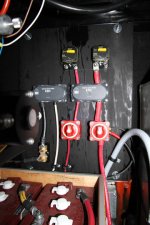If you're going to power all your loads by your inverter, then you'll indeed need 6 AWG. I only power 4 circuits -- microwave, and the 3 outlet circuits -- in a breakout box, for which 10 AWG is recommended. I saw no reason not to use standard Romex wiring, as all of the rest of the Cyclone (AC) wiring is Romex.
My main reason to use marine grade is because of my boating experience. Ancor marine grade wire is tough and very flexible. They use many fine, silver tinned strands. I always have some laying around and I have a commercial account for West Marine, changes the cost factor quite a bit. The flexible stuff is also easier to run where a lot of twists and turns make the path.
My inverter has a pass through switch, which just passes shore AC power through when shore power is available. The inverter doesn't know the difference between actual shore power or generator power. The transfer switch takes care of that upstream and independent of the inverter.
Previous experience with inverters with transfer switches will have me getting the next one with the switch. Unlike the transfer switch in our trailers, the inverter will switch from shore power to inverter output in milliseconds. Fast enough that you will not see your TV or computer blink. The transfer switches in the trailers have a delay. The better inverters, and most likely including the one you have, “clean” the output power before passing through which is good for your sensitive electronics. I have a 32” Sony and 26” Sansui flat screens, Blu-Ray player and usually 2 laptops plugged in. So the thought of clean, regulated power is comforting.
And as you can see, wiring it this way allows all circuits to have access to inverter output, not necessarily to be used, but capable of a pick and choose.

